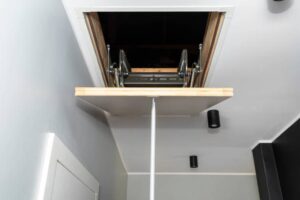Roof Access Hatches: Finding Roof Access Hatches Design
Roof hatches are an integral part of a building’s access and ventilation systems. They provide convenient and safe access to the roof.
A poor roof access hatches design can pose a safety issue. For instance, if it is too small and is installed above a ladder, there may not be enough headroom for people to descend from the ladder safely.
Ease of Operation
Roof hatches are designed to make it easier and safer for building personnel to access the roof area of a building. They provide easy entry to the roof for maintenance, transportation of equipment and rooftop installations such as HVAC systems. Prior to the development of roof hatches, people needed to use caged ladders that required a long vertical climb from a lower level. These could be dangerous in inclement weather and often allow unauthorized people to enter the roof area.
 Specialized hatches are also available for high-security applications such as prisons, banks and pharmacies where security is a key requirement. These hatches are manufactured from heavier gauge materials and come with options such as bullet-resistant view windows and deadlocks.
Specialized hatches are also available for high-security applications such as prisons, banks and pharmacies where security is a key requirement. These hatches are manufactured from heavier gauge materials and come with options such as bullet-resistant view windows and deadlocks.
In addition to providing safe roof access, these specialized hatches also serve as skylights. By allowing natural daylight to penetrate the roof space, they can create a more pleasant working environment in commercial and industrial spaces. They can also help reduce energy consumption and costs.
Standard products are offered in a variety of sizes and materials, with hot-dip galvanized steel being the most popular. Other options include aluminium, stainless steel and copper at varying price points. Most have features such as lift assistance, hold-open arms and insulation. They are typically made with a fully welded design and can be supplied with either an interior or exterior padlock hasp.
Safety
The proper implementation of safety regulations and the correct maintenance of roof hatches can reduce the risk of serious injuries when using them. In addition, they can make it easier for employees to access a rooftop to perform important maintenance work without the need for climbing ladders and other potentially hazardous methods.
The type of roof access hatches design used on a roof must meet certain building standards established to prevent falls from heights. These include safety railings around the hatch and delineating the edge of the roof itself. They also need to be large enough to allow a person to enter the rooftop with their arms and legs spread out and not touching the side of the hatch door when it’s open.
Additionally, the frequency and purpose of a person’s use of the roof access hatch should be considered to determine the size of the hatch required. For example, if individuals will be moving bulky tools or parts up onto the roof for replacement or repair work, a larger access hatch with stairs should be considered.
In ensuring that the hatch can remain open during rooftop activity, a gate should be installed at the top of the entranceway to the hatch. It will prevent the hatch from accidentally shutting on a worker and trapping them on the roof. It’s also possible to have the gate automatically close when workers walk past it.
Weather Resistance
Rooftop areas in non-residential buildings need to be accessed for HVAC maintenance and rooftop installations. Previously, this required climbing through caged ladders on the outside of the building, a long and risky climb in inclement weather conditions. Using a ceiling hatch eliminates the need for exterior ladder access and makes it safer to maintain the rooftop equipment.
Roof access hatches can be fabricated in various material options depending on geographic location and maintenance considerations. Galvanized steel is a common choice that provides a basic level of corrosion resistance. Aluminium is more costly but offers a greater level of corrosion resistance, particularly in coastal environments. Many manufacturers offer custom finishes, including Kynar and Tnemec coatings, which can provide added corrosion resistance.
A number of manufacturers also offer roof access hatches design with a polycarbonate dome cover to provide the added benefit of natural daylighting. This feature can help reduce energy costs for a building and create a more pleasant working environment for employees.
Most roof access hatches can be fitted with additional safety features to protect workers. A guardrail is a standard option that can prevent falls, especially in high winds. In addition, most hatches have a push lock that helps to keep the cover securely closed and a padlock tab for extra security. Most manufacturers also offer interior and exterior cylinder locks to prevent unauthorized access.
